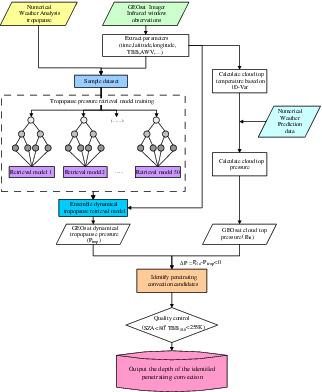当前位置:
X-MOL 学术
›
Q. J. R. Meteorol. Soc.
›
论文详情
Our official English website, www.x-mol.net, welcomes your feedback! (Note: you will need to create a separate account there.)
Tropopause‐penetrating convection in the extratropics: A satellite‐based investigation for the year 2018
Quarterly Journal of the Royal Meteorological Society ( IF 8.9 ) Pub Date : 2021-02-01 , DOI: 10.1002/qj.3994 Yi‐Xuan Shou 1 , Feng Lu 1 , Fu Wang 1
Quarterly Journal of the Royal Meteorological Society ( IF 8.9 ) Pub Date : 2021-02-01 , DOI: 10.1002/qj.3994 Yi‐Xuan Shou 1 , Feng Lu 1 , Fu Wang 1
Affiliation

|
Tropopause‐penetrating convection (or “overshooting convection” [OC]) is defined as a meso‐to‐microscale stratosphere–troposphere exchange process caused by deep convection. OC plays an important role in stratosphere–troposphere exchange and in producing turbulence. Compared with the tropics, the characteristics of OC in the extratropics are poorly understood. To this end, a high‐resolution and objective satellite‐based OC identification and classification algorithm was developed. In the algorithm, a machine learning method was utilized to derive tropopause height directly from satellite observations to ensure a high level of consistency between tropopause and cloud top height variations. By studying the climatology of OCs, including geographic distribution, vertical extent, and seasonal and diurnal variation, as well as their linkage with turbulence in the extratropics in 2018 based on Fengyun‐4A geostationary meteorological satellite data, it was found that most OCs in the extratropics have relatively shallow vertical extents and are more likely to occur over complex topography within the cyclonic curvature side of subtropical jets near the exit region, with a total frequency lower than 0.2%. They showed significant seasonal and diurnal variation. OCs in the Northern Hemisphere occurred most frequently during spring and summer and peak in the afternoon, while those in the Southern Hemisphere were more likely to occur in winter and spring, and with the highest likelihood in the early morning. Typical synoptic conditions for the occurrence of OCs in the mid–high latitudes of the Northern Hemisphere in the summer months included low‐level easterly flows, increased moisture symmetric instability, upper cold trough (or cold vortex), and a subtropical westerly jet. Under this large‐scale flow pattern, moderate‐to‐greater turbulence was often found to occur within or about 200 km away from the core convective area. The stronger the penetrating convection, the greater the probability of moderate‐to‐greater turbulence.
中文翻译:

温带对流层对流层穿透对流:2018年基于卫星的调查
穿透对流层的对流(或“超调对流” [OC])被定义为深对流引起的中微尺度平流层-对流层交换过程。OC在平流层-对流层交换和产生湍流中起着重要作用。与热带地区相比,温带海洋中OC的特征了解得很少。为此,开发了一种基于卫星的高分辨率,客观的OC识别和分类算法。在该算法中,采用了一种机器学习方法来直接从卫星观测中得出对流层顶高度,以确保对流层顶和云顶高度变化之间的高度一致性。通过研究OC的气候,包括地理分布,垂直范围以及季节和昼夜变化,根据风云4A对地静止气象卫星数据,以及与2018年温带湍流的联系,发现温带大多数OC的垂直范围相对较浅,并且更有可能发生在气旋曲率面内的复杂地形上出口区域附近的副热带急流,总频率低于0.2%。他们表现出明显的季节性和昼夜变化。北半球的OCs最常发生在春季和夏季,并在下午达到峰值,而南半球的OCs更可能发生在冬季和春季,而清晨的可能性最大。在夏季,北半球中高纬度地区OCs发生的典型天气条件包括低水平的东风,湿度对称不稳定,上部冷槽(或冷涡)和亚热带西风急流增加。在这种大规模的流动模式下,通常发现在中心对流区域内或距离中心对流约200 km处发生了中到更大的湍流。穿透对流越强,中等至更大湍流的可能性就越大。
更新日期:2021-03-07
中文翻译:

温带对流层对流层穿透对流:2018年基于卫星的调查
穿透对流层的对流(或“超调对流” [OC])被定义为深对流引起的中微尺度平流层-对流层交换过程。OC在平流层-对流层交换和产生湍流中起着重要作用。与热带地区相比,温带海洋中OC的特征了解得很少。为此,开发了一种基于卫星的高分辨率,客观的OC识别和分类算法。在该算法中,采用了一种机器学习方法来直接从卫星观测中得出对流层顶高度,以确保对流层顶和云顶高度变化之间的高度一致性。通过研究OC的气候,包括地理分布,垂直范围以及季节和昼夜变化,根据风云4A对地静止气象卫星数据,以及与2018年温带湍流的联系,发现温带大多数OC的垂直范围相对较浅,并且更有可能发生在气旋曲率面内的复杂地形上出口区域附近的副热带急流,总频率低于0.2%。他们表现出明显的季节性和昼夜变化。北半球的OCs最常发生在春季和夏季,并在下午达到峰值,而南半球的OCs更可能发生在冬季和春季,而清晨的可能性最大。在夏季,北半球中高纬度地区OCs发生的典型天气条件包括低水平的东风,湿度对称不稳定,上部冷槽(或冷涡)和亚热带西风急流增加。在这种大规模的流动模式下,通常发现在中心对流区域内或距离中心对流约200 km处发生了中到更大的湍流。穿透对流越强,中等至更大湍流的可能性就越大。



























 京公网安备 11010802027423号
京公网安备 11010802027423号